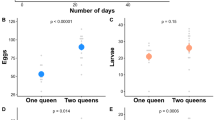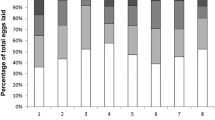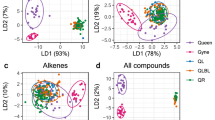Abstract
Animal societies are stages for both conflict and cooperation. Reproduction is often monopolized by one or a few individuals who behave aggressively to prevent subordinates from reproducing (for example, naked mole-rats1, wasps2 and ants3). Here we report an unusual mechanism by which the dominant individual maintains reproductive control. In the queenless ant Dinoponera quadriceps, only the alpha female reproduces. If the alpha is challenged by another female she chemically marks the pretender who is then punished4 by low-ranking females. This cooperation between alpha and low-rankers allows the alpha to inflict punishment indirectly, thereby maintaining her reproductive primacy without having to fight.
This is a preview of subscription content, access via your institution
Access options
Subscribe to this journal
Receive 51 print issues and online access
$199.00 per year
only $3.90 per issue
Buy this article
- Purchase on Springer Link
- Instant access to full article PDF
Prices may be subject to local taxes which are calculated during checkout




Similar content being viewed by others
References
Clarke, F. M. & Faulkes, C. G. Dominance and queen succession in captive colonies of the eusocial naked mole-rat, Heterocephalus glaber. Proc. R. Soc. Lond. B 264, 993–1000 (1997)
Röseler, P.-F. in The Social Biology of Wasps (eds Ross, K. G. & Matthews, R. W.) 309–335 (Cornell Univ. Press, Ithaca, 1991)
Heinze, J., Hölldobler, B. & Peeters, C. Conflict and cooperation in ant societies. Naturwissenschaften 81, 489–497 (1994)
Clutton-Brock, T. H. & Parker, G. A. Punishment in animal societies. Nature 373, 209–216 (1995)
Peeters, C. in Queen Number and Sociality in Insects (ed. Keller, L.) 234–261 (Oxford Univ. Press, Oxford, 1993)
Monnin, T. & Peeters, C. Monogyny and regulation of worker mating in the queenless ant Dinoponera quadriceps. Anim. Behav. 55, 298–306 (1998)
Monnin, T. & Peeters, C. Dominance hierarchy and reproductive conflicts among subordinates in a monogynous queenless ant. Behav. Ecol. 10, 323–332 (1999)
Wilson, E. O. The Insect Societies (Harvard Univ. Press, Cambridge, Massachusetts, 1971)
Billen, J. & Morgan, E. D. in Pheromone Communication in Social Insects. Ants, Wasps, Bees, and Termites (eds Vander Meer, R. K., Breed, M. D., Espelie, K. E. & Winston, M. L.) 3–33 (Westview, Boulder, 1998)
Keller, L. & Nonacs, P. The role of queen pheromones in social insects: queen control or queen signal? Anim. Behav. 45, 787–794 (1993)
Ortius, D. & Heinze, J. Fertility signalling in queens of a North American ant. Behav. Ecol. Sociobiol. 45, 151–159 (1999)
Monnin, T. & Peeters, C. Cannibalism of subordinates' eggs in the monogynous queenless ant Dinoponera quadriceps. Naturwissenschaften 84, 499–502 (1997)
Hölldobler, B. & Wilson, E. O. The Ants (Harvard Univ. Press, Cambridge, Massachusetts, 1990)
Regnier, F. E. & Wilson, E. O. Chemical communication and “propaganda” in slave-maker ants. Science 172, 276–269 (1971)
Allies, A. B., Bourke, A. F. G. & Franks, N. R. Propaganda substances in the cuckoo ant Leptothorax kutteri and the slave-maker Harpagoxenus sublaevis. J. Chem. Ecol. 12, 1285–1293 (1986)
Heinze, J., Oberstadt, B., Tentschert, J., Hölldobler, B. & Bestmann, H. J. Colony specificity of Dufour gland secretions in a functionally monogynous ant. Chemoecology 8, 169–174 (1998)
Gobin, B., Billen, J. & Peeters, C. Policing behaviour towards virgin egg layers in a polygynous ponerine ant. Anim. Behav. 58, 1117–1122 (1999)
Liebig, J., Peeters, C. & Hölldobler, B. Worker policing limits the number of reproductives in a ponerine ant. Proc. R. Soc. Lond. B 266, 1865–1870 (1999)
Monnin, T. & Ratnieks, F. L. W. Policing in queenless ponerine ants. Behav. Ecol. Sociobiol. 50, 97–108 (2001)
Monnin, T., Malosse, C. & Peeters, C. Solid phase microextraction and cuticular hydrocarbon differences related to reproductive activity in the queenless ant Dinoponera quadriceps. J. Chem. Ecol. 24, 473–490 (1998)
Liebig, J., Peeters, C., Oldham, N. J., Markstädter, C. & Hölldobler, B. Are variations in cuticular hydrocarbons of queens and workers a reliable signal of fertility in the ant Harpegnathos saltator? Proc. Natl Acad. Sci. USA 97, 4124–4131 (2000)
Cuvillier-Hot, V., Cobb, M., Malosse, C. & Peeters, C. Sex, age and ovarian activity affect cuticular hydrocarbons in Diacamma ceylonense, a queenless ant. J. Insect Physiol. 47, 485–493 (2001)
Stacey, P. B. & Koenig, W. D. Cooperative Breeding in Birds. Long Term Studies of Ecology and Behaviour (Cambridge Univ. Press, Cambridge, 1990)
Solomon, N. G. & French, J. A. Cooperative Breeding in Mammals (Cambridge Univ. Press, Cambridge, 1997)
Ratnieks, F. L. W. Reproductive harmony via mutual policing by workers in eusocial hymenoptera. Am. Nat. 132, 217–236 (1988)
Ratnieks, F. L. W. & Visscher, P. K. Worker policing in the honeybee. Nature 342, 796–797 (1989)
Barron, A., Oldroyd, B. P. & Ratnieks, F. L. W. Worker reproduction in honey-bees (Apis) and the anarchic syndrome: a review. Behav. Ecol. Sociobiol. 50, 199–208 (2001)
Foster, K. R. & Ratnieks, F. L. W. Social insects: Facultative worker policing in a wasp. Nature 407, 692–693 (2000)
Foster, K. R. & Ratnieks, F. L. W. Convergent evolution of worker policing by egg eating in the honeybee and common wasp. Proc. R. Soc. Lond. B 268, 169–174 (2001)
Peeters, C., Monnin, T. & Malosse, C. Cuticular hydrocarbons correlated with reproductive status in a queenless ant. Proc. R. Soc. Lond. B 266, 1323–1327 (1999)
Acknowledgements
We thank IBAMA for permission to collect Dinoponera in Brazil, and T. Clutton-Brock, M. Cobb, K. Foster, A. Hefetz, L. Keller, J. Liebig and C. Peeters for comments. T.M. was funded by a Marie Curie individual fellowship from the European Union programme Training and Mobility of Researchers.
Author information
Authors and Affiliations
Corresponding author
Ethics declarations
Competing interests
The authors declare that they have no competing financial interests.
Rights and permissions
About this article
Cite this article
Monnin, T., Ratnieks, F., Jones, G. et al. Pretender punishment induced by chemical signalling in a queenless ant. Nature 419, 61–65 (2002). https://doi.org/10.1038/nature00932
Received:
Accepted:
Issue Date:
DOI: https://doi.org/10.1038/nature00932
This article is cited by
-
Functional morphology of the Dufour gland in the queenless ant Dinoponera quadriceps
Insectes Sociaux (2024)
-
Functional properties of ant queen pheromones as revealed by behavioral experiments
Behavioral Ecology and Sociobiology (2023)
-
Reproduction and signals regulating worker policing under identical hormonal control in social wasps
Scientific Reports (2020)
-
Queen honey bee (Apis mellifera) pheromone and reproductive behavior are affected by pesticide exposure during development
Behavioral Ecology and Sociobiology (2020)
-
Dominance Hierarchy, Ovarian Activity and Cuticular Hydrocarbons in the Primitively Eusocial Wasp Mischocyttarus cerberus (Vespidae, Polistinae, Mischocyttarini)
Journal of Chemical Ecology (2020)
Comments
By submitting a comment you agree to abide by our Terms and Community Guidelines. If you find something abusive or that does not comply with our terms or guidelines please flag it as inappropriate.



